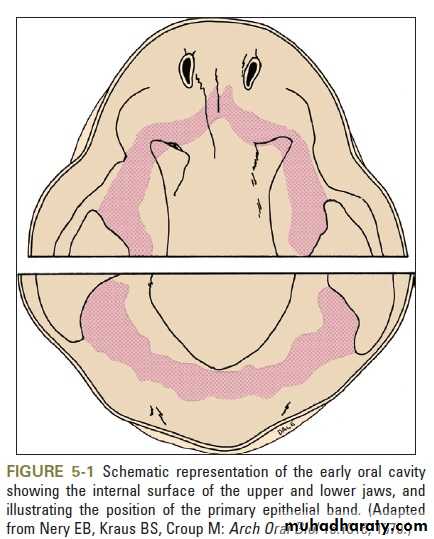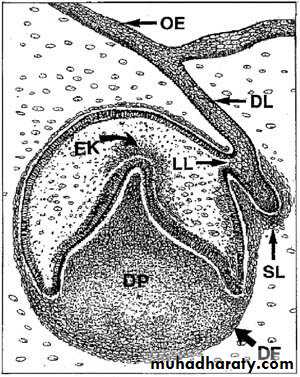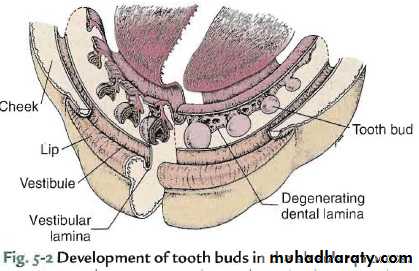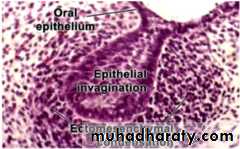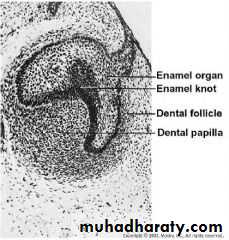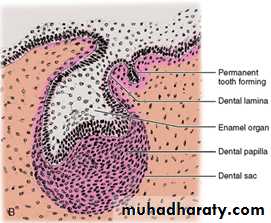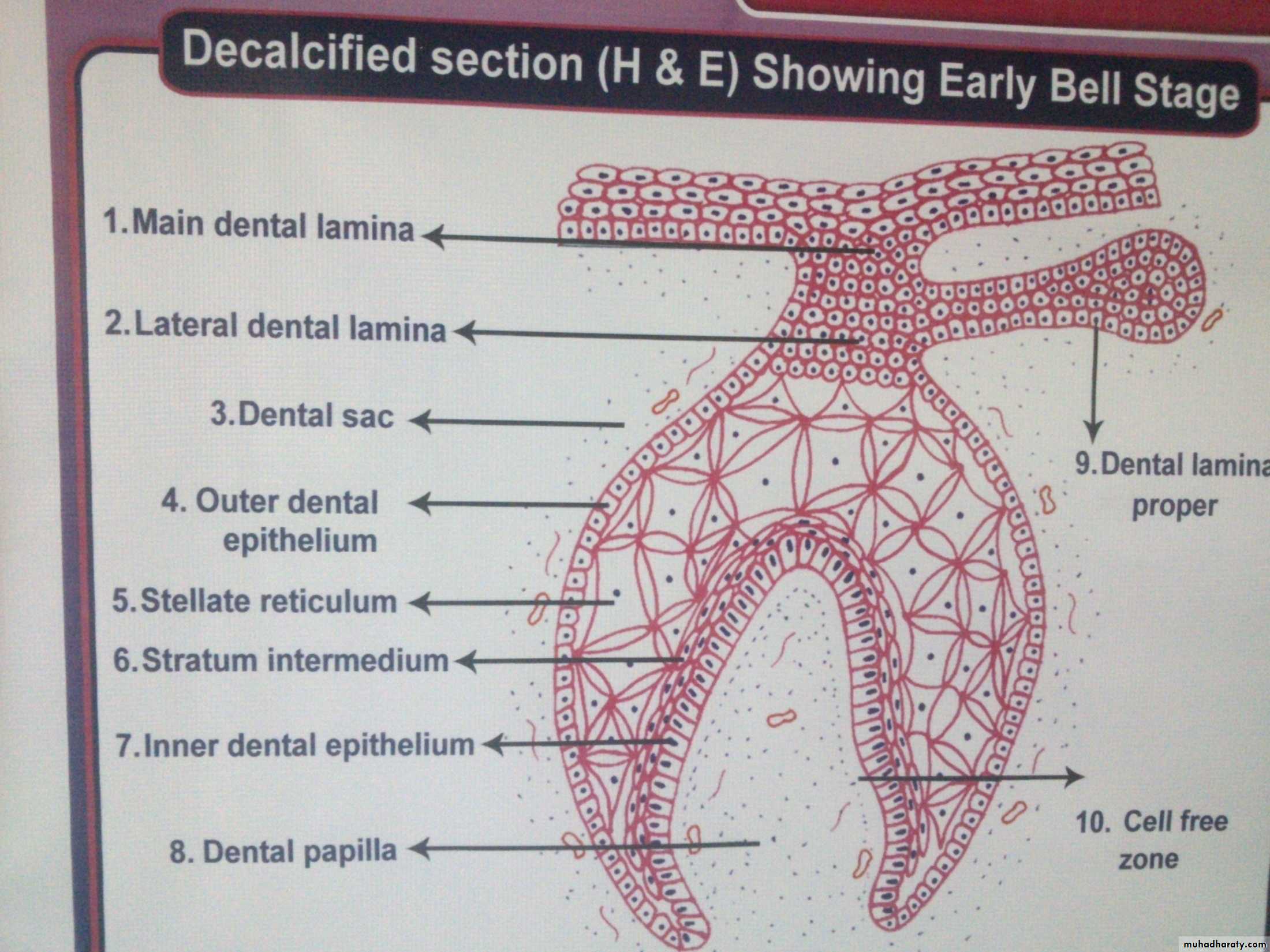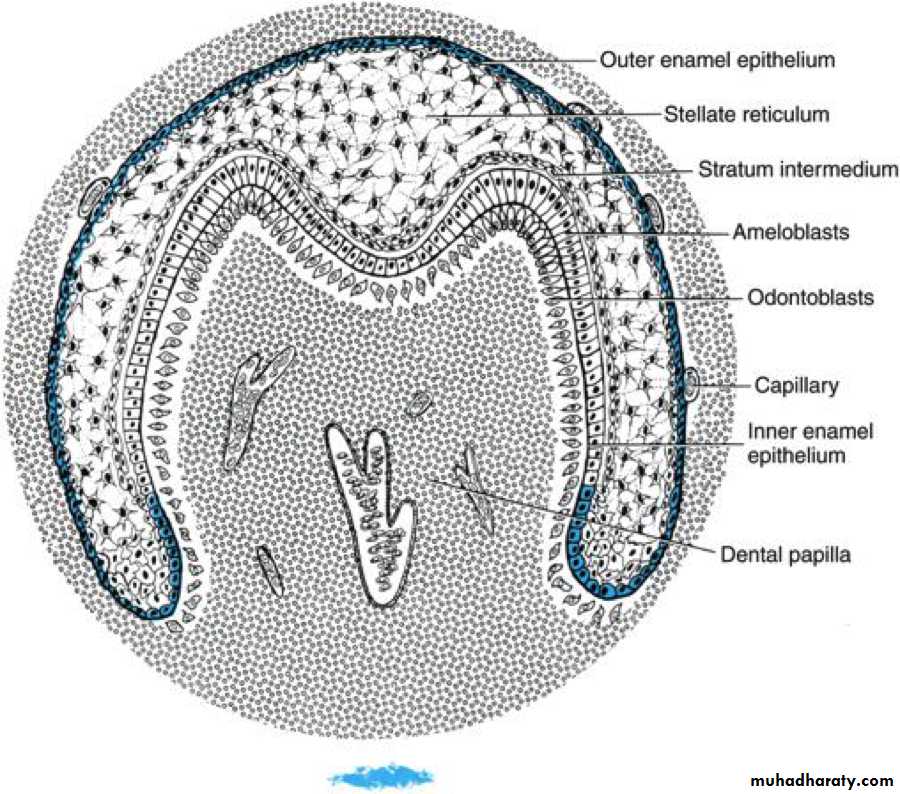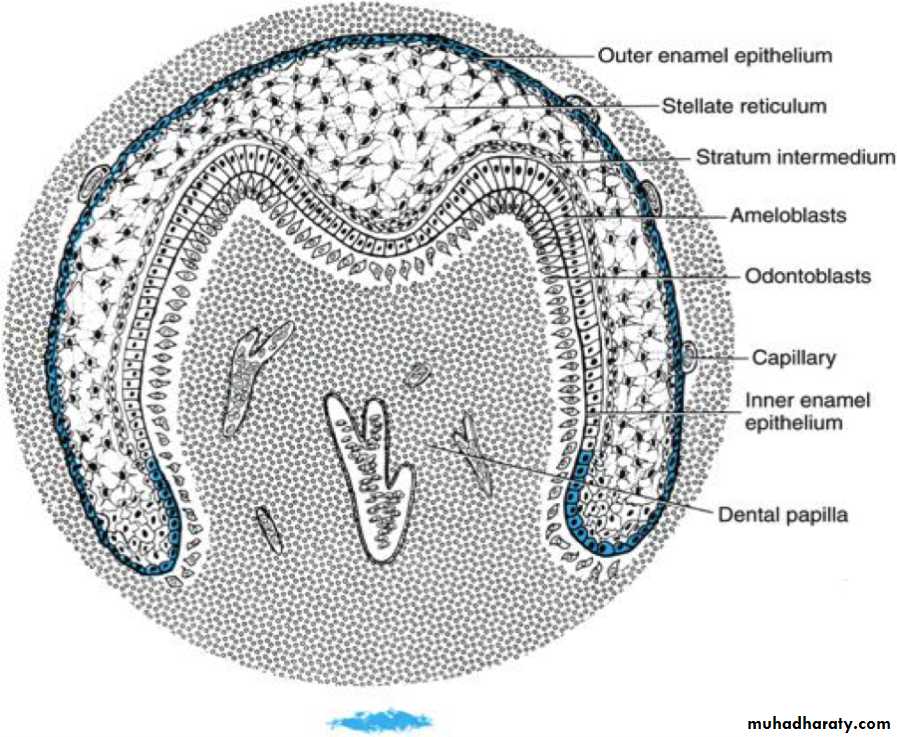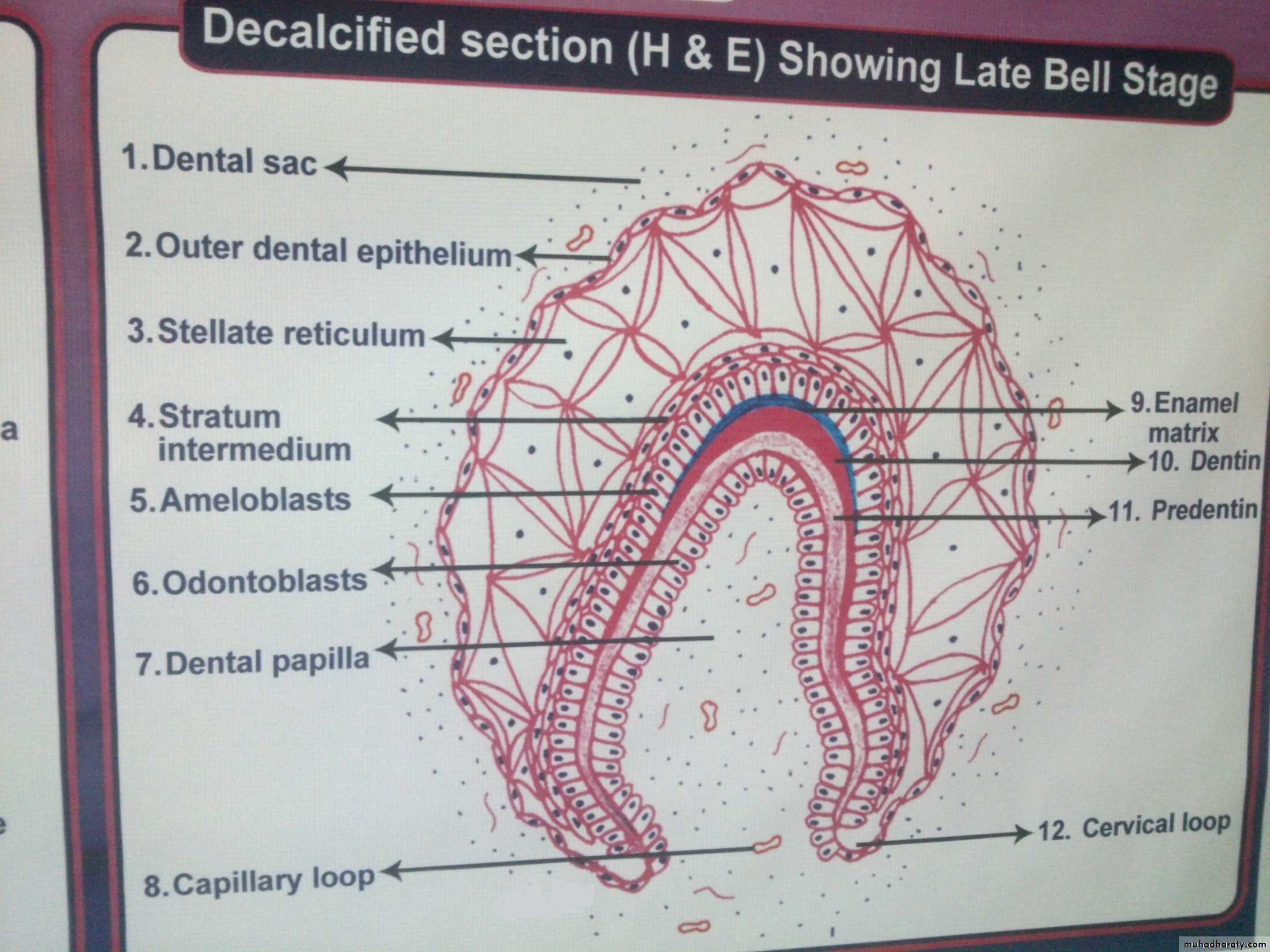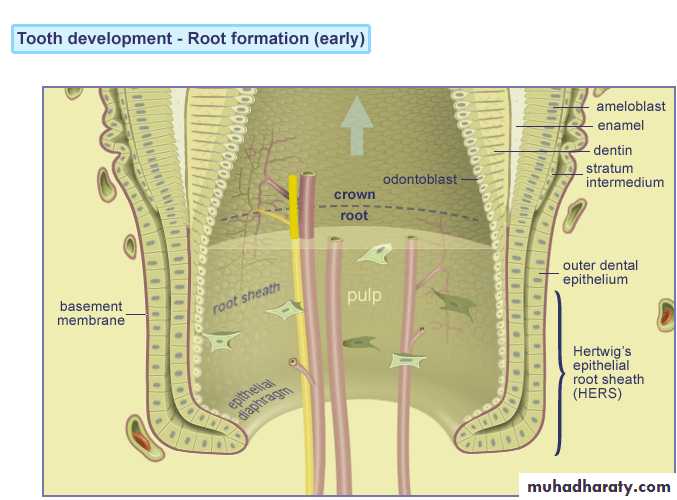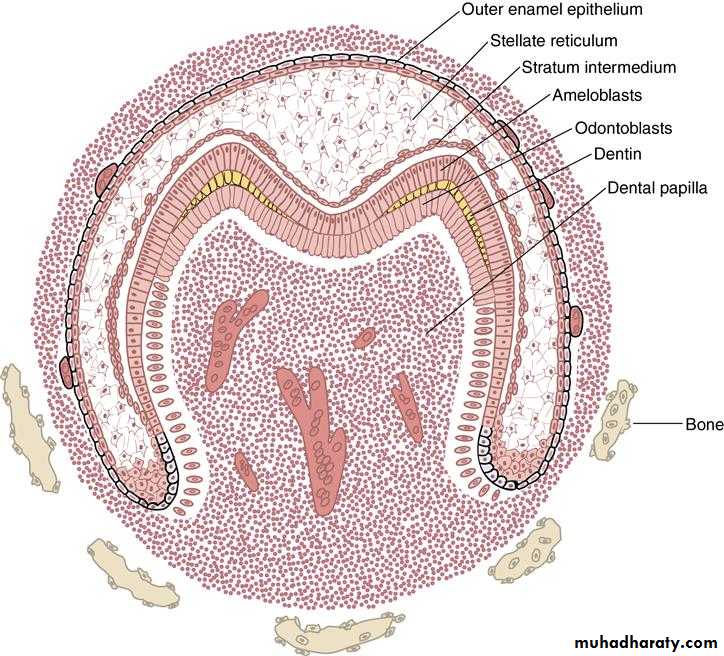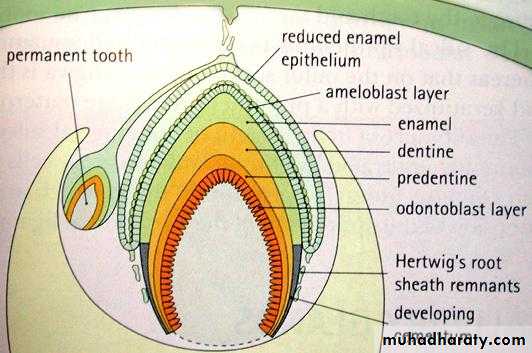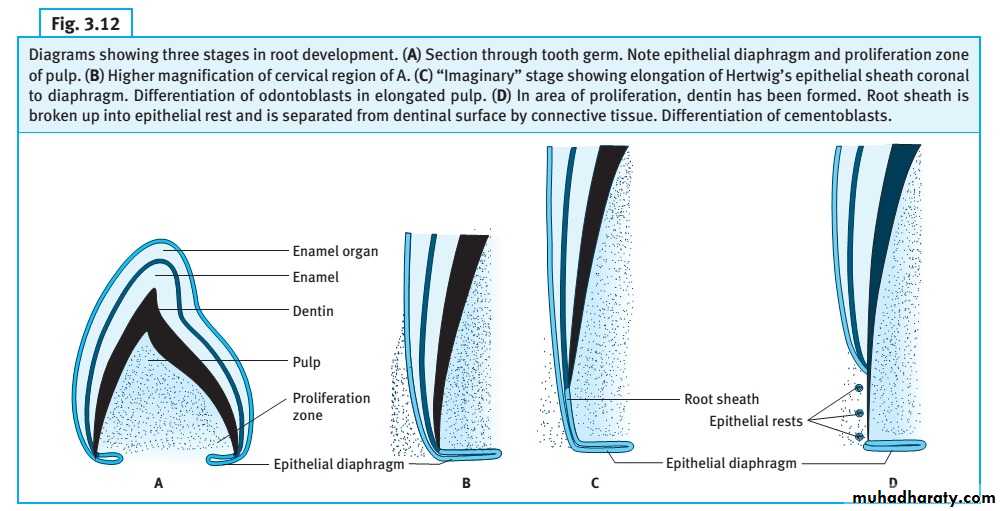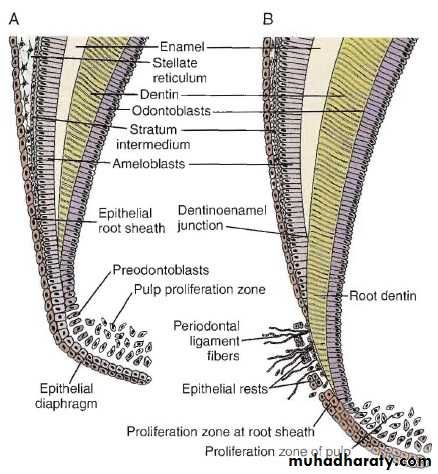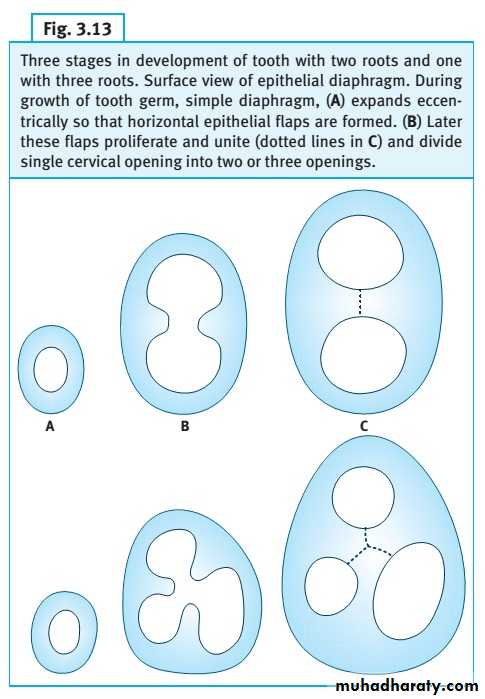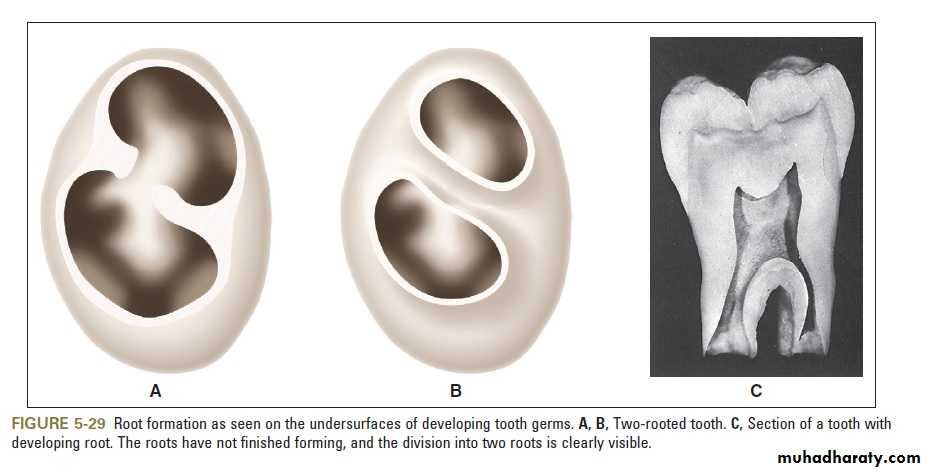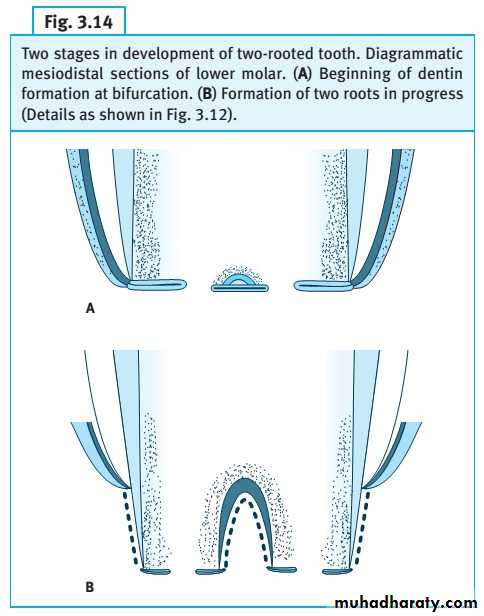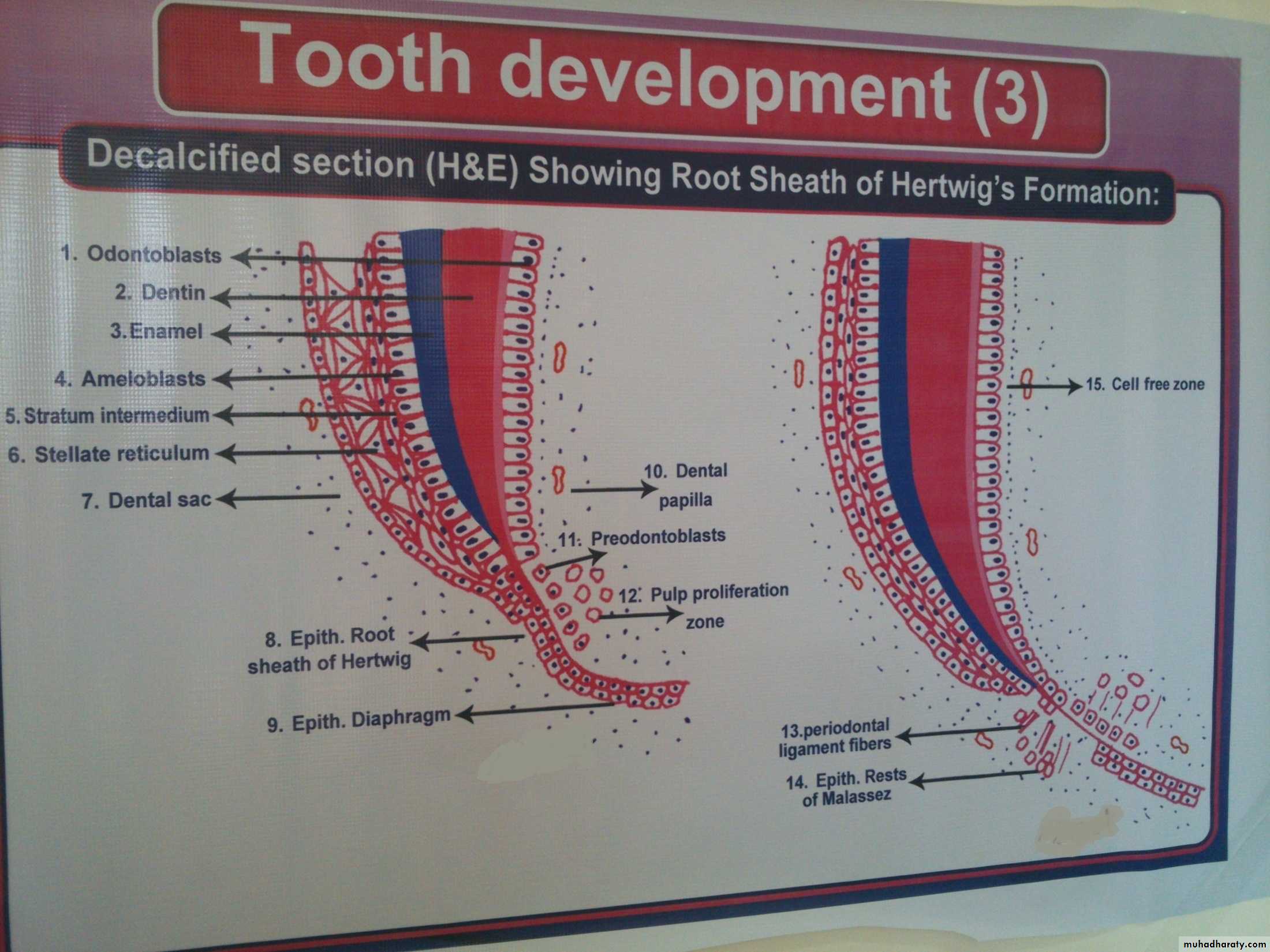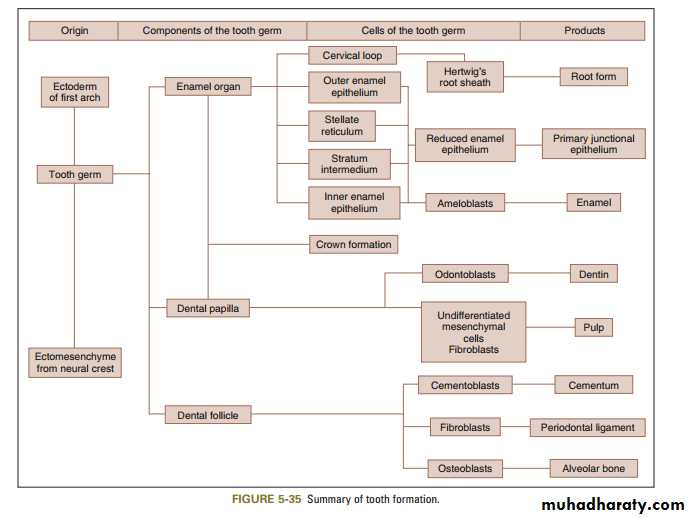Development of Teeth
In the human 20 primary and 32 permanent teeth develop from the Interaction of the oral epithelial cells derived from the first arch and the underlying ectomesenchymal cells derived from neural crest cell .Most of the connective tissue cells underlying the oral ectoderm are of ectomesenchyme in origin
These cells instruct the overlying ectoderm to start the tooth development, which begins in the anterior portion of the future maxilla & mandible and proceeds posteriorly.
a continuous band of thickened epithelium forms around the mouth in the presumptive upper and lower jaws. These bands are roughly horseshoe-shaped and correspond in position to the future dental arches of the upper and lower
jaws
Initiation
When the embryo is about 6 weeks old, certain areas of basal cells of oral ectoderm proliferate rapidly, leading to the formation of primary epithelial bandThe band invades the underlying ectomesenchyme along each of the horse-shoe shaped future dental arches.
Tooth formation occurs in the 6th week of intrauterine life with the formation of primary epithelial band. At about 7th week the primary epithelial band divides into
1- a lingual process called dental lamina (forms first).
2- a buccal process called vestibular lamina (forms shortly afterward).All deciduous teeth arises from dental lamina, later the permanent successors arise from its lingual extension & permanent molars from its distal extension
1- DENTAL LAMINA
dental lamina is a localized thickenings or placodes within the primary epithelial bands.the anterior aspect of the dental lamina, continued and localized proliferative activity leads to the formation of a series of epithelial outgrowths into the mesenchyme at sites corresponding to the positions of the future deciduous
teeth.
Ectomesenchymal cells accumulate around these outgrowths. From this point, tooth development proceeds in three stages: the bud, cap, and bell
• The successors of the deciduous teeth develop from a lingual extension of the free end of the dental lamina opposite to the enamel organ of each deciduous teeth.
The lingual extension of the dental lamina is named the successional lamina
DENTAL LAMINA
• 20 areas of enlargement or knobs appear, which will form tooth buds for the 20 primary teeth• Not all will appear at the same time. The first to develop are those of the anterior mandible region
• At this early stage the tooth buds have already determined their crown morphology
As the cell proliferation occurs each enamel organ takes a shape that resembles a cap• The dental lamina begins to function at 6th prenatal week and continues to 15th year of birth (3rd molar)
2- VESTIBULAR LAMINA
Labial and buccal to the dental lamina in each dental arch, another epithelial thickening develops independentlyIt is Vestibular Lamina also termed as lip furrow band
Subsequently hollows and form the oral vestibule between the alveolar portion of the jaws and the lips and cheeks.Stages of tooth development
1. Bud stage.2. Cap stage.
3. Bell stage.
1- BUD STAGE
Is a rounded localized growth of epithelial cells surrounded by proliferating mesenchymal cells.
This is the initial stage of tooth formation where enamel organ resembles a small bud
1- BUD STAGE
The area of ectomesenchymal condensation subjecent to enamel organ is dental papilla.The condensed ectomesenchyme that surrounds the tooth bud and dental papille is the dental sac.
The dental papilla as well as the dental sac are not well defined during the bud stage, they become more defined during the subsequent cap & bell stages
dental papilla
dental sac2- CAP STAGE
As the tooth bud grows larger, it drags along with it part of the dental laminaAs the tooth bud continues to proliferate, it does not expand uniformly into a large sphere Instead unequal growth in different parts of the tooth bud leads to the cap stage which is characterized by a shallow invagination on the deep surface of the bud
2- CAP STAGE
The peripheral cells of the cap stage are cuboidal , cover the convexity of the cap & are called the outer enamel epitheliumThe cells in the concavity of the cap become tall columnar cells & represent the inner enamel epithelium
stellate reticulum
The cells in the center of the enamel organsynthesize and secrete glycosaminoglycans into the extracellular compartment between the epithelial cells
Glycosaminoglycans are hydrophilic and so pull water into the enamel organ from dental papilla
the central cells are forced apart and because they retain connections with each other through their desmosomal contacts, they become star-shaped
2- CAP STAGE
The epithelial outgrowth,which superficially resembles a cap sitting on a ball of condensed ectomesenchyme, is referred to widely as the dental organ but actually should be called the enamel organ because it eventually will form the enamel of the tooth
2- CAP STAGE
The ball of condensed ectomesenchymal cells, called the dental papilla,will form the dentin and pulp.The condensed ectomesenchyme limiting the dental papilla and encapsulating the enamel organ—the dental follicle or dental sac—gives rise
to the supporting tissues of the tooth
2- CAP STAGE
The enamel organ, dental papilla, and dental follicle together constitute the tooth germ.tooth germ
3- Bell Stage
During this stage, the tooth crown assumes its final shape (morphodifferentiation)
the cells that will be making the hard tissues of the crown (ameloblasts and odontoblasts) acquire their distinctive phenotype (histodifferentiation).
INNER ENAMEL EPITHELIUM
The inner enamel (dental) epithelium consists of a single layer of cells that differentiate prior to amelogenesis into tall columnar cells called ameloblastsThe cells of the inner enamel epithelium exert a strong influence on the underlying mesenchymal cells of the dental papilla, which later differentiate into odontoblasts
The inner enamel epithelium completes its folding, making it possible to recognize the shape of the future crown pattern of the tooth
STRATUM INTERMEDIUM
A fourth layer in the enamel organ is composed of stratum intermedium cells , which lie adjacent to the inner enamel epithelial cells (between the inner enamel epithelium & the stellate reticulum). They assist the ameloblast in the formation of enamelSTELLATE RETICULUM
The stellate reticulum expands further due to continued accumulation of intra-cellular fluid
As the enamel formation starts., the Stellate reticulum collapses to a narrow zone thereby reducing the distance between the outer & inner enamel epithelium
OUTER ENAMEL EPITHELIUM
The cells of the outer enamel epithelium flatten to form low cuboidal cellsThe outer enamel epithelium is thrown into folds which are rich in capillary network, this provides a source of nutrition for the enamel organ (spesificaly to ameloblast)
The region where the inner and outer
enamel epithelia meet at the rim of the enamel organ is known as the zone of reflexion or cervical loopAfter the enamel organ is differentiated the dental lamina begins to degenerate by undergoing lysis.
Dental papilla
Cells in the periphery of the dental papilla become odontoblats (differentiate from mesenchymal cells) These cells elongate and become columnar and form a matrix of collagen fibers identified as predentin which becomes dentin.the vessels entering the papilla are clustered into groups that coincide with the position where the roots will form.
When dentinogenesis begins, the nerve fibers penetrate the dental papilla (pulp)
DENTAL SAC
The dental sac exhibits a circular arrangement of fibers & resembles a capsule around the enamel organThe fibers of the dental sac form the periodontal ligament fibers that span between the root & the bone
Dentinogenesis
The undifferentiated ectomesenchymal cells in dental papilla increase rapidly in size and ultimately differentiate into odontoblasts, the dentin-forming cells.The differentiation of odontoblasts from the undifferentiated ectomesenchyme of the dental papilla is initiated by an organizing influence
from the cells of the inner enamel epithelium
Dentinogenesis
The odontoblasts begin to elaborate the organic matrix of dentinAs the organic matrix is deposited, the odontoblasts move toward the center of the dental papilla
The dentinal matrix is first a meshwork of collagen fibers, but within 24 hours it becomes calcified
It is called predentin before calcification and dentin after calcification
Increments of dentin are formed along the dentinoenamel junction
Amelogenesis
Inner enamel epithelium cells continue their differentiation into ameloblasts that produce organic matrix against the newly formed dentinal surface.
Almost immediately, this organic matrix mineralizes and becomes the initial enamel layer of the crown.
After the first layer of dentin is formed, the ameloblasts lay down enamel over the dentin in the future incisal & cuspal areas
Amelogenesis
Thus although enamel protein secretion occurs before mantledentin is visible on the crown, these proteins do not assemble as a layer until dentin has formed.
The enamel-forming
cells, the ameloblasts, move away from the dentin, leaving behind an ever-increasing thickness of enamel
ROOT FORMATION
Once crown formation is completed, epithelial cells of the inner and outer enamel epithelium proliferate from the cervical loop of the enamel organto form a double layer of cells known as Hertwig’s epithelial
root sheath.
This sheath of epithelial cells extends around the dental pulp between the latter and the dental follicle until it encloses all but the basal portion of the pulp.
The rim of this root sheath, the epithelial diaphragm, encloses the primary apical foramen.
ROOT FORMATION
As the inner epithelial cells of the root sheath progressively enclose more and more of the expanding dental pulp, they initiate the differentiation of odontoblasts from ectomesenchymal cells at the periphery of the pulp, facingthe root sheath.
These cells eventually form the dentin of the root. In this way a single-rooted tooth is formed
If two tongues of epithelium diaphragm growing toward each other from Hertwig’s epithelial root sheath it allows an appreciation of how a primary apical foramen is converted into two secondary apical foramina and if three tongues are formed, three secondary apical foramina arise.
Hertwig’s epithelial root
sheath extends around each apical foramen forming as manyepithelial tubes that evolve similarly as in single-rooted teeth.
FORMATION OF SUPPORTING TISSUES
The supporting tissues of the tooth form from the dental follicle.1- As the root sheath fragments, ectomesenchymal cells of the dental follicle penetrate between the epithelial fenestrations and become
apposed to the newly formed dentin of the root.
these cells differentiate into
cementum-forming cells (or cementoblasts).
2- some cells from Hertwig’s epithelial root sheath may transform directly into cementoblasts, and may also give rise to other periodontal
components.
The bone in which the ligament fiber bundles are embedded also is formed by cells that differentiate from the dental follicle.


